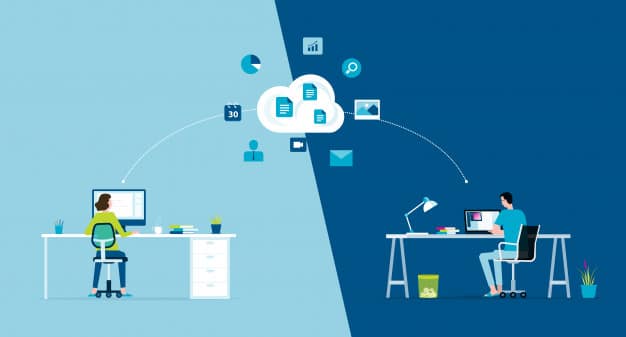The COVID-19 pandemic poses a serious threat to health and life and profoundly affects our lifestyle: social distance, remote work, restricted and smart working.
As more countries start moving towards lifting the lockdown that has been imposed on people to halt the spread of COVID-19, enterprises are looking at the new reality of work once we arrive at what is now being described as the new normal. One of the work models that was widespread during the lockdown and which many workers are looking to continue is the idea and practice of smart working.
COVID-19 did not start the smart working trend, but it pushed it to the fore. Even before the pandemic, some companies allowed employees to work from home. Almost 30% of employees worked at least part of the time remotely before the current crisis. However, many companies were suspicious about telecommuting due to potential issues with productivity, collaboration, and morale.
For example, Mr. Pichai, the CEO of Google, wrote. “We are testing a hypothesis that a flexible work model will lead to greater productivity, collaboration, and well-being.”
Sundar Pichai also said that the organization was making changes to its offices that would better support employees in the future. This includes “reconfiguring” office spaces to accommodate “on-sites,” days when employees who regularly work from home will enter the workplace.
“I see the future as definitely being more flexible,” Pichai said during a video interview for Time 100, “We firmly believe that in-person, being together, having that sense of community, is super important for whenever you have to solve hard problems, you have to create something new,” he said. “So we don’t see that changing, so we don’t think the future is just 100% remote or something.”
Smart working is the future?
For many employees, the ability to work from home, co-working spaces, coffee shops – or anywhere there’s an internet connection – is a key part of balancing work and life and getting the most out of each.
A staggering 99% of the 2,500 respondents said they’d like to work at least some of the time remotely in a worldwide previous survey.
However, remote working isn’t just about staying away from the office. Decoupling work from a specific place, time and device let employees find working patterns that suit them and their lifestyle, helping them deliver their best. Multiple surveys show that offering remote working is key to attracting and retaining the best staff in a competitive recruitment landscape.
There are other benefits for businesses. With fewer employees on-site, offices are smaller and cheaper to run. Staff can be more highly motivated and more productive. The business has more agility and greater ability to flex with a changing world. And as the COVID-19 coronavirus crisis shows, changes can be sudden, unprecedented, and even existential.
Remote Working as New Normal?
After the transition to working-from-home, many managers skeptical about managing workplaces saw that it was possible. They just had to follow basic rules like setting clear goals, being transparent about the company priorities, outlining responsibilities, and using tools that help everyone stay in touch (e.g., cloud collaboration solutions)
For organizations with the proper remote work solutions in place, complete with policies and guidelines, it is fair to say that 5% of workforces who previously worked in-office will permanently remain remote. All decisions to have a portion of their employees work remotely on a more permanent basis should be thoroughly evaluated. In addition to physical cost savings, considerations should include role or function, the organization’s workplace culture, and most importantly, whether the proper tools and resources are in place for the role to be successful. This is for the benefit of the remote employees and the entire organization to communicate, collaborate, and share knowledge to ensure continued productivity and business effectiveness.
New Work Models
Business leaders need to communicate and remain transparent with their employees to build a suitable working model for everyone. Some employees may be eager to return to the office, while others have found remote work suits their needs best. In the long-term, it will be necessary to provide guidance to employees and adjust expenditures (such as reducing real estate costs) if a hybrid work model will be adopted. This will go a long way in building trust and loyalty between your employees and the organization.
Conclusion
Smart working offers, of course, advantages and disadvantages for both the worker and the company, which you will know below.
Advantage of Smart Working:
- It increases the worker’s freedom and autonomy. It has a greater capacity to organize your time.
- It saves you money on workspaces, transport, or supplies (electricity, heating, etc.)
- You can save a lot of time on journeys, especially in big cities.
- It improves the reconciliation of work-life with personal and family life, which is often highly valued.
- If the work is well structured (usually based on objectives), productivity can be increased.
- An improvement in the worker’s quality of life is noticed. The worker values the work and the company. This can attract talent to the business.
- It allows the integration of people with reduced mobility.
Disadvantages of Smart Working:
- The worker sees his personal life invaded by the work.
- It might lead to the isolation of the worker due to not having contact with peers. This can also cause feelings of not being identified with the company.
- If distance work is not well planned or executed, productivity may decrease. There may be less control over the quantity or quality of work.
- Part of the company’s savings can mean expenses for the worker (in the workspace, cost of supplies, etc.).
Our personal idea Is that The Best Future Work Model will definitely be more flexible. It will be a smart combination of working from home and working in the office.
Discover how Convergence Consulting can help your business to implement smart working.




Leave a Reply